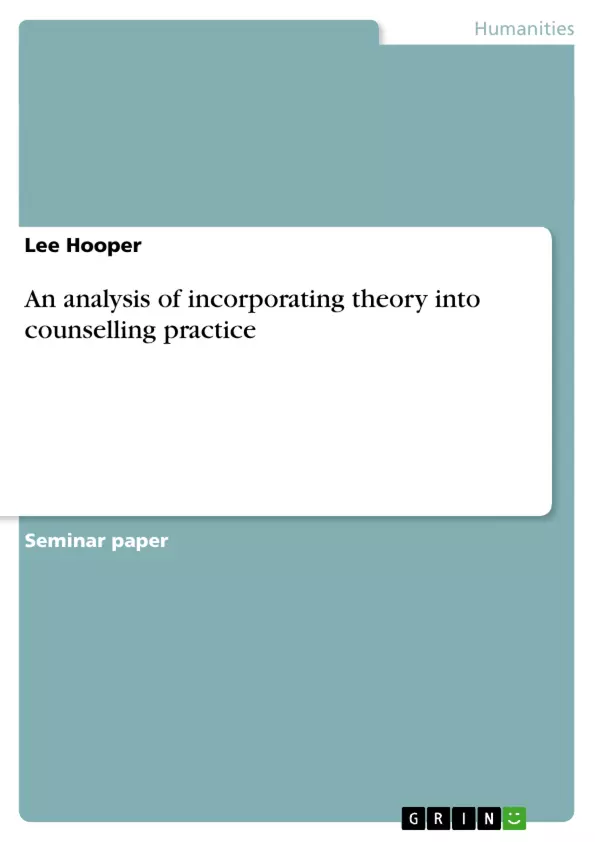Establishing a strong therapeutic relationship within counselling practice is one of the most vital aspects in achieving a positive outcome for the client. There are many techniques available to the counsellor in achieving this, including a wide variety of theoretical approaches. The question of whether applying these theoretical approaches to practice is necessary, and to what degree, is a contented issue amongst counsellors, with responses depending heavily on which theoretical model of counselling is being utilised. In this essay it will be argued that theory is necessary to establish an effective counselling practice, only to the degree in which the chosen style of therapy used actually incorporates theory into its practice. Relatively speaking, this is meant that theory is only necessary for an effective counselling practice when the practitioner, and their theoretical position, both consider it to be so. This will be shown by first giving a general definition of counselling – both in relation to theory and practice, outlining some of the major counselling theoretical positions, and then demonstrating how each of these positions places emphasis on theory in relation to practice. It is concluded that applied theory is necessary within a counselling practice, with the degree of importance directly relating to which theory is used and the cultural values present where it is practiced.
Inhaltsverzeichnis (Table of Contents)
- Establishing a strong therapeutic relationship within counselling practice
- Defining Counselling
- Counselling in a Western Context
- Opposing Theoretical Approaches
- Psychodynamic counselling
- Cognitive-behavioural therapy
- The Humanistic Approach
- Person-centred counselling
- The Gestalt Approach
- Emphasising the 'here and now'
Zielsetzung und Themenschwerpunkte (Objectives and Key Themes)
This essay aims to explore the necessity and degree of theory incorporation in counselling practice, arguing that theory is essential for effective practice but only to the extent that the chosen therapeutic style incorporates it. The essay will examine the various theoretical approaches within counselling, focusing on how each position emphasizes theory in relation to practice.
- The importance of establishing a strong therapeutic relationship in counselling
- The role of theory in counselling practice
- The differences between theoretical approaches in counselling, particularly the emphasis on theory versus experience
- The impact of cultural context on counselling practice
- The use of theory in different counselling approaches, including psychodynamic, cognitive-behavioural, person-centred, and gestalt therapy
Zusammenfassung der Kapitel (Chapter Summaries)
The essay begins by defining counselling and outlining its cultural context, emphasizing the professional role counselling plays in the Western world. It then contrasts two opposing theoretical approaches: those that take a "heavy" theoretical stance (psychodynamic and cognitive-behavioural) and those that emphasize a more "heart-felt" and "experiential" approach (person-centred and gestalt therapy).
The essay then delves into the psychodynamic approach, explaining its focus on understanding unconscious processes and their influence on current decisions. It highlights the use of theory in techniques like case history taking, free association, and transference/counter-transference.
Next, the essay explores cognitive-behavioural therapy, emphasizing its focus on identifying and reconciling maladaptive cognitive processes. It describes how the approach employs theory in identifying schemas, automatic thoughts, genetic factors, and underlying beliefs.
The essay then shifts to the humanistic approach, focusing on person-centred and gestalt therapy. It explains how these approaches prioritize a genuine relationship with the client, with less emphasis on theory compared to other approaches. The essay highlights the importance of empathy, trust, and unconditional acceptance in person-centred therapy, and the focus on the "here and now" in the gestalt approach.
The essay concludes by highlighting the importance of cultural context and the possibility of alternative, less theory-driven approaches to counselling, such as Zen principles, which emphasize experience over theory.
Schlüsselwörter (Keywords)
The main keywords and focus topics of this essay include counselling, theory, practice, therapeutic relationship, psychodynamic therapy, cognitive-behavioural therapy, humanistic therapy, person-centred therapy, gestalt therapy, cultural context, Western counselling, and Zen principles.
- Quote paper
- Lee Hooper (Author), 2011, An analysis of incorporating theory into counselling practice, Munich, GRIN Verlag, https://www.grin.com/document/262257



